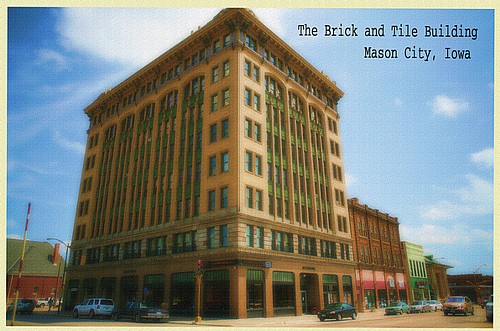


Cerro Gordo County Iowa
Part of the IaGenWeb Project
|
a.k.a. Brick and Tile Building 103 E. State St., Mason City IA

The MBA Building was built during 1916 and 1917 for the Modern Brotherhood of America, a fraternal lodge. The primary
purpose of the lodge, originally formed in 1897 and located in Tipton, Iowa, was to provide life insurance benefits for its members.
Mason City successfully lobbied the lodge to relocate its headquarters in 1915. The building site was the former
location of the Elks Lodge in downtown Mason City. Designed by architects Bell and Bentley of Minneapolis Work, construction
began on May 18, 1916. The 8-story building was designed according to Classical Revival principals with a base, shaft
and capital. The MBA Building was dedicated on June 6th and 7th of 1917 with former President William Howard Taft
delivering the dedicatory speech. It was the tallest building in Mason City.
Original businesses in the MBA Building were:
Basement - barber shop, cafe, billiard and pool hall, Noiseless Bowling Alley
1st Floor - retail shops and stores
2nd Floor - shops, office rooms, sales of high-class specialties and commodities
3rd, 4th, 6th Floors - office rooms
5th Floor - physicuan and dentist offices
7th Floor - lawyer and attorney offices
8th Floor - Modern Brotherhood of America offices
Roof - observatory area
When the MBA Lodge merged with the Independent Order of Foresters in 1931, the Independent Order of Foresters
assumed ownership of the MBA Building. The MBA
Building was sold to the Goodwin family of Des Moines in 1947, and the Mason City Brick and Tile Company in 1948. Naturally, the new owners renamed the building
after the company. In 1973, the William J. Brandenburg family, owners of the Brick and Tile Company, sold
the building in 1973 to State Street Investment Ltd. which was owned by John and Tel Pappajohn. The Pappajohns
began renovations. Brian Crane bought the MBA Building in March of 2001. Among present-day tenants are
Chicago Style Deli, Full Service Salon and Spa, YMCA Healthy Living Center, Habitat for Humanity, Pappajohn Law Firm,
Brick & Tile Office and Wright on the
Park. The original wood
and glass vestibule enclosures have survived over time as has the original staircase with marble stair plates.
Mason City's M.B.A. building was added to the National Register of Historic Places on September 12, 2002.
Globe Gazette
completed in 1917, into the 21st century
He points out that when the building was dedicated in 1917, William Howard Taft, former president of the United States, was the guest speaker at a banquet sponsored by the Rotary Club.
One of the Rotary members in attendance, according to the program, was Lt. Hanford MacNider, who had not yet been promoted to the rank of general.
Most of that history was in the 20th century. Now, Crane wants to bring the building into the 21st century to attract clientele whose wants and needs are far different than the doctors, lawyers, druggists, accountants and all manner of businessmen and women who have done business there for almost 90 years.
"The building is made of steel, concrete, marble and granite, and to this day is still very modern," Crane said.
It is steel-framed and eight stories high, and measures 82 feet north to south and 114 feet east to west. The lobby has Carrara marble walls, an original brass mail drop and an original staircase with marble stair plates.
"It was created as a fraternal office building for an insurance company with the rest being rented out. It was pretty much just an office building," Crane said.
That fit 20th century needs.
Crane is looking ahead, and what he sees is a "Brick and Tile Center" in concept, if not in name.
"If you're not tap dancing to the show that people want to see, you won't sell any tickets," he said.
So Crane has put in a conference room on the fourth floor that is available for anybody in the community to rent.
A health and fitness center is under construction in the basement that will include exercise equipment, men and women's showers, full-size lockers and cable TV.
"We have a wonderful new YMCA, but when it moved out of downtown, a lot of people who used to use the Y during their lunch hour couldn't do it any more," he said.
"When this is completed, downtown business people can come in, put their work clothes in our full-size lockers, work out, get ready to go back to work and even have time for lunch."
He pointed out they can have their lunch in his building, at the Bean Scene, a coffee shop and restaurant with entrances on Delaware Avenue, and also from the lobby of his building.
On the second floor, a spa and salon are under construction to attract the attention of women — something that was hardly a priority in the early days when the building didn't even have women's restrooms, said Crane.
The modernization is not limited to the inside.
The roof of the building is another source of income because many businesses have made arrangements to have their antennas, dishes and other communications equipment there.
"This building is the hub for fiber optics. Every form of communication exists here," Crane said.
"The good news is there are more opportunities for growth now than ever before. The bad news is the opportunities are much more sophisticated now.
"But we have to rise to the challenge of the times," he said. "If we don't, we'll be a dinosaur."

Transcriptions and Submission by Sharon R. Becker, November of 2013
|
Return to Cerro Gordo's National Register of Historic Places Index Page
Return to Cerro Gordo History Index Page Return to Cerro Gordo Home Page